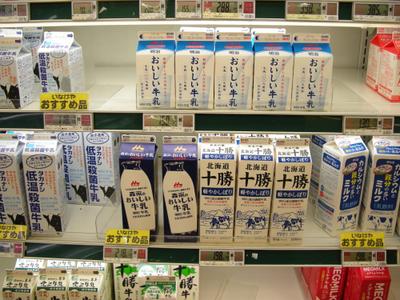It may seem like a cruel April Fool's joke, but it isn't: after dozens of years without change, the prices of many staple foods in Japan are set to rise steeply this month [ja], following a trend that began with the price of bread, constant for 24 years [ja] but already up more than 10% [ja] over the past year. The coming changes have spurred fears of a major shake-up in the industry, motivating renewed efforts at increasing the country's record low self-sufficiency rate and convincing some to return to traditional Japanese foods [ja].
April 1st, the start of the new fiscal year in Japan, marks the day when a number of changes come into effect. Unchanged for 30 years, the price of milk will see an increase, as will the price of many other food commodities, including beer, shoyu (soy sauce) and cooking oil [ja], not to mention more luxurious items like ice cream [ja]. With changes also in Japan's health care system and (at least momentarily) the end of the country's provisional gasoline tax, there is no lack of uncertainty regarding the upcoming transition in the economy. A recent survey nonetheless showed that while Japanese feel that a hike in food prices will cause great problems, if the hike is for the sake of food safety, then they consider it “unavoidable”.

Milk in Japanese supermarket

Bread in Japanese supermarket
Blogger Kagemusha (影武者) describes the basic situation:
さて、本日で暫定税率が失効となり明日からガソリンが値下がりする動きとなるようですが、一方で原油の高値や異常気象などの影響から「4月から食品の値上げラッシュが勢いを増す」ようです。身近なものでは小麦を原料としたビールやパン、そして“物価の優等生”と言われた牛乳も飼料価格の高騰を背景に4月から値上げを実施する旨が各メディアで報じられています。
食料品の高騰はバイオマス燃料の原料となるトウキビなどの過剰使用による不足、サブプライム問題により多くの投資が大豆や小麦関連に向けられた事なども原因となっているようですがいずれにしましても一般家庭においては特に厳しい状況になっていく事は確かです。
The coincidence of the timing of the price hike did not go unnoticed, as blogger YUtoKEI points out:
いよいよ恐怖の4月が到来!?「エイプリルフールです!」で有ってほしいのですが、福田総理が”ごめんなさい”では済まされない。国民も生活防衛策を真剣に考えないといけない時代がやってきました。
While some bloggers have suggested the solution to the food crisis in Japan is to grow one's own food, many others have taken the move of stocking up early [ja], a plan that blogger hanamaru2224 considers:
明日から牛乳や醤油、小麦製品そしてなによりビールが値上げらしいけど買い溜めする?
牛乳の買い溜めってできないし(^^;)
Can't stock up on milk though (^^;)
In a post entitled “March 31st, change”, blogger psw_fragile reflects on all the transitions in Japan, including a change in the font size of newspapers to accommodate an aging population and the yearly April rush of new graduates into the work force:
今日は3月31日。
明日から4月、新年度に変わります。
平成20年のこの新年度には、これまでになく「変化」というものが感じられる年になりそうです。
原油価格の高騰から、食品が一斉に値上げされます。
ガソリンも急激に値上がり。
そして、今日から新聞の文字の大きさも変わり、新入社員が増え、車では若葉マークが増える・・・。
Tomorrow is April, and we change to the new fiscal year.
In this new fiscal year of 2008, it seems like we are entering a year in which changes will be felt that are unlike anything that has come before.
The sudden price hike in crude oil will all of a sudden increase the price of food commodities.
The price of gasoline will also suddenly go up.
And then, from today, the font size of newspapers is also changing, there are lots of new employees, lots of stickers for new car drivers…
Blogger DeepSky, meanwhile, delves deeper into the unique challenge facing Japanese:
日本の食糧自給率は世界的に見ても先進国中で最下位。
オーストラリア237%、カナダ145%、アメリカ128%、フランス122%、ドイツ84%、イギリス70%、イタリア62%、スイス49%、韓国47%、日本39%。
穀物では自給率がほぼ100%のコメ(と言っても、こちらも崩壊寸前らしい)を除き、大半を輸入に頼っています。
中でもトウモロコシは、96%をある国から輸入しているのですが、どこでしょう?
Australia is 237%, Canada 145%, USA 128%, France 122%, Germany 84%, England 70%, Italy 62%, Switzerland 49%, South Korea 47%, Japan 39%.
With the exception, among grains, of rice, for which self-sufficiency is 100% (and even here, this [industry] is also on the brink of collapse), [Japan] depends on imports for the majority [of its food intake].
Above all, we are importing 96% of corn from a certain country, do you know which one?
そう、バイオエタノールブームに湧く米国です。
トウモロコシに作付けを切り替える農家が急増して、大豆や小麦の生産が減少。
更に北京オリンピックバブル(笑)で経済成長著しい中国での需要拡大、オーストラリアの大干ばつによる小麦の生産減などの影響が加わり、トウモロコシと大豆の相場価格はここ3年で約2.5倍、小麦は約3倍に急騰。
穀物価格の高騰と調達難が、自給率の低い日本の食に襲いかかってきているわけです。
There are more and more farmers who are switching to planting corn, and the production of soya beans and wheat are decreasing.
Furthermore, with the increasing influence of expanding demand in China, where there is considerable growth with the Beijing Olympics bubble (LOL), and the decrease in wheat production in Australia as a result of the Big Dry, the market price of corn and soya beans has jumped in 3 years to 2.5 times its original price, while wheat has jumped to 3 times its original price.
As a country with a low degree of self-sufficiency, this is why Japan is taking such a beating from the sudden hike in grain prices and difficulties with supply.
Blogger yuujii_1946 spells out what needs to happen in order to confront this situation:
39%の日本の自給率を高めるには、日本の農業や漁業の改革・踏ん張りに期待せねばならないのですが、消費者の理解も必要です。安心して食べられる食品への意識の変遷と、価格の高騰はその追い風となります。
Blogger plasticpaper263, in contrast, points the finger at a different group:
瞬時に世界を駆け巡り、より利潤上がる商品に向かって金持ちの投機マネ−が一斉に損失を最小限にするために「サブプライムを含んだ債券証券」を如何に売り抜けるか。そして投機は原油や金、食料になる小麦などに向かって集中し、小麦とその関連食品やガソリン、灯油の値上げがりとなつて庶民の生活に甚大な被害を与えだしたのだ。
Finally, blogger jf3mwqinasaku sums up the situation this way:
もはや お金さえあれば 海外から食料を調達できる時代は過去のものとなりつ
つもあります利便性だけでムダの多い日本の食糧事情 その大半を安い海外の原材料と労働力
にたより捨てる部分の多い不効率さ経済の原則も大事だけど それも考え直さないと行けない時期にきているのかも
しれません。
The age in which we were able to get our food from overseas just by having money will soon be a thing of the past.
Japan's food situation, just convenience, and lots of waste.
The inefficiency of having to rely on cheap ingredients and labor from overseas, and of throwing away so much.
Economic principles are important, but the time has come that we need to reevaluate them.







3 comments